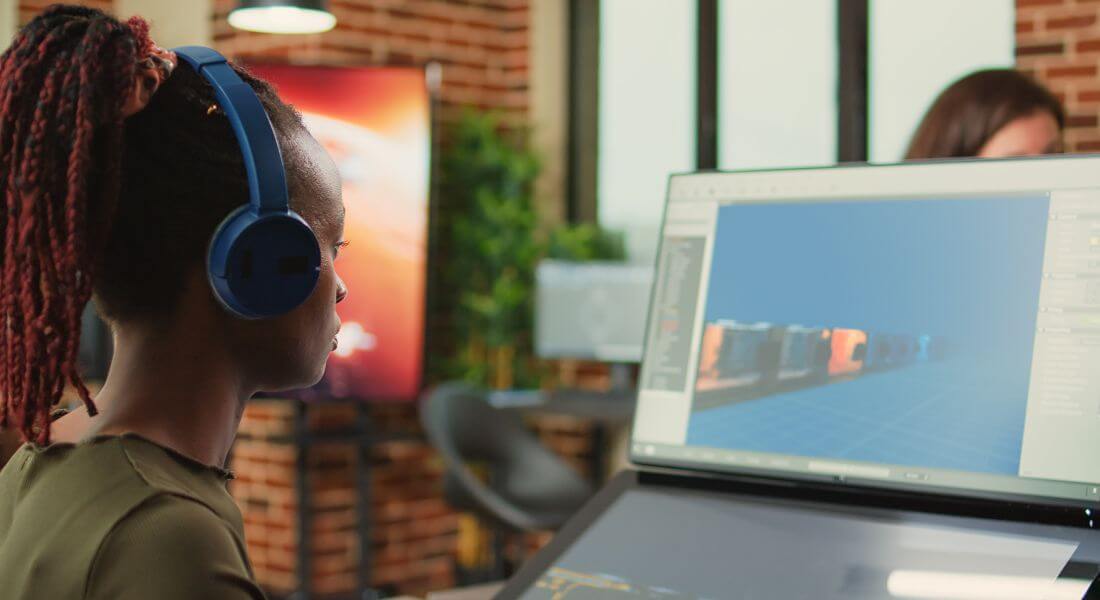
When it comes to creating high-quality videos, many people instinctively focus on visuals: lighting, framing, animation, or camera angles. While visuals certainly matter, what often gets overlooked is audio the quiet hero of every great production. Good audio doesn’t just complement your visuals; it actively shapes how your message is received.
Whether it’s an interview, a corporate message, or an animated explainer, poor sound can break the immersion and reduce credibility. Viewers may tolerate slightly grainy visuals, but they will quickly disengage if the audio is unclear, inconsistent, or jarring. Crisp, balanced audio keeps your audience engaged and builds trust with every word.
In this article, we’ll explore why sound is such a critical component of video production. We’ll also share practical tips for capturing professional audio in various formats, from on-location shoots to studio voiceovers, so your message lands exactly as intended.
1. Audio Quality Shapes Viewer Perception Instantly
The moment someone hits play on your video, they’re subconsciously evaluating whether to keep watching and sound plays a huge role in that decision. Clean, well-leveled audio signals professionalism and helps establish credibility right away. On the flip side, if your audio is echoey, muffled, or noisy, it immediately distracts and reduces trust. People may assume your message lacks care or quality, even if your visuals are excellent.
First impressions happen fast, especially on social media or during client presentations. Good audio creates a sense of immersion, keeping viewers focused on your message instead of struggling to hear it. Your tone, pacing, and clarity all contribute to how your content is perceived. Even subtle flaws can break concentration and push people to click away.
Don’t underestimate the impact of sound on branding and authority. Clear audio reinforces your message and helps position your business as detail-oriented and reliable. That’s especially true for corporate and testimonial videos, where trust is key. Investing in great sound is a fast way to upgrade your entire production value.
2. Poor Audio Undermines Even the Best Visuals
It’s tempting to pour all your effort into visuals and treat sound as an afterthought but that’s a risky approach. Bad audio has the power to overshadow even the most polished footage. If viewers can’t hear the speaker properly or are distracted by background noise, the visuals won’t save the experience. People come for the content, but they stay when they can hear it clearly.
This is especially true in interviews, webinars, and corporate training where clarity is critical. Your visuals might look great, but without crisp audio, your message will fall flat. Even a few seconds of distorted or low-quality sound can derail the entire viewer experience. The frustration builds quickly and affects retention rates.
Always remember that audio is half the experience in any video. Prioritising it ensures that all your other production work has the impact it deserves. Don’t let sound be the weak link that holds everything back. Take it seriously from the start of every shoot.
3. Audio Helps Deliver Emotion and Nuance
The human voice carries more than just words it conveys emotion, intention, and subtle shifts in tone that text or visuals alone can’t replicate. This emotional layer is what connects viewers to the speaker and message. Whether it’s a heartfelt testimonial or an energetic product launch, audio helps translate feeling. Without that depth, videos often feel flat or robotic.
In animation and explainer videos, the voiceover is especially important. It brings the script to life and gives personality to otherwise abstract visuals. A well-delivered line can elevate even the simplest motion graphic. Conversely, monotone or poorly recorded narration can make your video feel dull and lifeless.
Background music and sound effects also play a powerful role in emotional storytelling. They guide mood, tempo, and viewer expectations in ways that visuals can’t do alone. Audio sets the atmosphere and tells the brain how to feel. Getting this right can be the difference between a forgettable video and one that lingers in memory.
4. Clear Sound Enhances Accessibility and Inclusion
Good audio isn’t just about quality it’s about making your content accessible to everyone. Clear, consistent speech helps viewers with hearing difficulties, non-native speakers, or people watching in noisy environments. When your audio is muddled or fast-paced, you risk excluding part of your audience. Great sound opens the door to wider reach and better communication.
Captions and transcripts are helpful, but they’re not a substitute for good audio. Viewers often rely on both simultaneously, especially in professional or educational content. If your audio is poor, even the best captions can’t fully recover the experience. And not all platforms support high-quality subtitles automatically.
Think of sound as a bridge, not a barrier. Prioritising clarity and volume balance means you’re respecting your audience’s diverse needs. That’s not just smart it’s the mark of a thoughtful and inclusive brand. Clear audio shows that every viewer matters.
5. Microphone Choice Makes All the Difference

One of the easiest ways to improve audio instantly is to use the right microphone for the setting. Built-in camera mics often pick up too much ambient noise and deliver flat, tinny results. External microphones like lavaliers, shotgun mics, or USB studio mics offer better directionality and clarity. Choosing the right mic for your environment is crucial for consistent, high-quality sound.
Lavalier mics are ideal for interviews and talking heads, offering clean speech capture close to the source. Shotgun mics work well in controlled environments or directional setups. For voiceovers or screen recordings, a condenser mic provides a rich, full tone. Each option brings its own strengths and challenges.
Investing in a quality mic pays dividends across multiple shoots. It saves time in post-production and reduces the need for re-records or aggressive noise removal. The better your input, the easier it is to edit and polish. Audio capture isn’t an afterthought it’s a foundation.
6. Background Noise Can Sabotage Your Message
Even the best delivery can be ruined by distracting background noise like traffic, air conditioning, or office chatter. These sounds may seem minor during filming but become glaring distractions in post-production and for viewers. Background noise competes with your voice and pulls attention away from what matters most: your message.
In uncontrolled environments like outdoor shoots or busy offices, it’s essential to monitor ambient sound actively. Use windshields, directional microphones, or even temporary soundproofing to manage the noise level. Taking precautions during recording can save hours of editing later and preserve the clarity of your content.
Remember, your viewers won’t blame the environment they’ll blame the production. Distracting noises break immersion, reduce professionalism, and can make your content feel rushed or unplanned. Minimising interference keeps your audience focused, comfortable, and engaged with your message throughout.
7. Room Acoustics Affect Recording Quality
The space you record in has a major influence on how your audio sounds. Hard surfaces like tile floors, windows, or blank walls can cause echoes or reverb, making speech muddy or harsh. Even a high-end microphone will struggle in a poorly treated room. That’s why understanding room acoustics is key to any successful shoot.
To reduce echo, add soft materials like curtains, rugs, or foam panels that absorb sound. Recording in a smaller, padded space often improves clarity dramatically. For remote recordings, even basic steps like putting a blanket over a desk or recording in a closet can make a big difference.
These adjustments may seem small, but they impact every second of your audio. Cleaner input leads to a more polished final product. When planning a shoot, factor in the acoustic environment not just the visual backdrop to ensure your video sounds as good as it looks.
8. Monitoring Audio in Real Time Prevents Surprises
One of the biggest mistakes in video production is failing to monitor sound while recording. Without headphones on set, you might miss subtle issues like hums, clipping, or inconsistent volume. These problems often go unnoticed until post-production, when it’s too late to fix them without major effort.
Using a simple pair of monitoring headphones allows your crew to catch and address problems on the spot. You can adjust mic positions, reduce interference, or re-record lines immediately. This saves time, maintains quality, and prevents costly reshoots.
It’s also important to do a quick sound check before you begin filming. Check levels, test your mic setup, and record a few seconds of dialogue. Getting it right before you press record can save hours in editing and protect your video’s overall integrity.
9. Voice Direction Improves Delivery and Tone
Even talented speakers benefit from direction when it comes to voice tone, pacing, and emphasis. Without proper coaching, voices can sound flat, rushed, or overly rehearsed. A well-directed voiceover or on-camera performance connects better with the audience and feels more authentic.
A director or producer can help guide the speaker’s rhythm and energy to match the content’s intent whether it’s authoritative, conversational, or inspiring. Small tweaks in tone or inflection can transform how the message is perceived. It’s not just what you say it’s how you say it.
Encouraging natural speech and real emotion leads to more engaging and persuasive audio. Take the time to rehearse, offer feedback, and experiment with different deliveries. This attention to voice quality helps elevate the entire production and brings your script to life.
10. Audio Consistency Builds Professionalism Across Edits
In videos with multiple scenes, speakers, or locations, inconsistent audio can disrupt flow and feel jarring. Differences in mic quality, background sound, or volume levels can make a single video feel disjointed. Consistent audio, on the other hand, helps stitch everything together into a cohesive viewing experience.
To achieve consistency, standardise your equipment, mic placement, and post-production settings. Use equalisation, normalisation, and noise reduction tools carefully to match audio tones between clips. Always listen to the full video as a viewer would before finalising it.
Audio consistency is one of the markers of professional content. It allows your message to shine without distractions and builds trust with your audience. Whether it’s a corporate brand video or a multi-person interview, consistent sound makes everything feel more polished and intentional.
11. Pre-Recording Sound Checks Avoid Issues Later

A quick pre-recording sound check might seem basic, but it can save a production from hours of rework. Testing your microphone, room tone, and recording levels before filming ensures your setup is ready. This lets you catch hums, pops, or low input that could ruin a take.
It’s a good habit to do a brief trial recording and listen back using proper headphones. You’ll often spot issues not noticeable during live monitoring. This small step builds confidence and prevents costly errors in post-production.
Including pre-checks in your production routine improves professionalism and saves time. It becomes part of your team’s rhythm, creating fewer surprises later. Clients will also appreciate the smooth, prepared workflow.
12. Sound Design Supports Your Visual Narrative
Sound design is not just an accessory it’s a storytelling tool. From subtle background ambience to dramatic whooshes and impactful transitions, audio effects help support the visual structure of your video. They guide the audience through changes in mood, pace, and emotion, often more powerfully than visuals alone.
For example, a gentle background hum in an office scene can add realism, while the absence of sound during a tense moment can build anticipation. Every auditory cue contributes to the viewing experience, reinforcing what viewers see and feel on screen. Thoughtful sound design also helps smooth transitions between scenes, creating a seamless viewing flow.
When sound design is done right, it’s often invisible but incredibly effective. It elevates the final video without drawing too much attention to itself. For brands aiming to deliver polished, cinematic content, sound design is a detail that makes a huge difference in perception and professionalism.
13. Syncing Audio and Visuals Enhances Impact
Synchronization is about making sure your audio aligns perfectly with your visuals. When speech doesn’t match lip movements or a sound effect feels off-timed, the result is jarring. It breaks immersion and undermines credibility. Viewers notice poor sync more than you might think.
Ensuring tight sync between narration, music cues, and on-screen actions helps the content feel cohesive and intentional. Whether it’s a product demo or a testimonial, this alignment reinforces the viewer’s connection to what they’re watching. Even background music that rises and falls with the action can dramatically enhance viewer engagement.
Great sync also shows attention to detail, which reflects well on your brand. It tells your audience you care about quality and user experience. That kind of care can be the difference between a video that’s merely watched and one that’s remembered.
14. Audio Editing is as Crucial as Video Editing

Audio doesn’t end once it’s recorded it needs editing to shine. Equalising voice levels, removing background hum, adding fades, and balancing music are all vital steps. Just like visual edits, audio edits shape the flow, tone, and clarity of your message.
Without proper audio editing, even well-recorded tracks can sound amateurish. Peaks and dips in volume, inconsistent tone, or abrupt cuts can distract and irritate your viewers. Editing smooths those edges and makes the audio sound professional, trustworthy, and pleasant to the ear.
When planning your video timeline, always budget time for audio editing. It’s not an optional polish it’s a necessary step. Audio editing can often be the hidden hero that lifts your production from average to excellent.
15. Investing in Audio Reflects Your Brand Standards
At the end of the day, everything your audience hears becomes part of your brand perception. Sloppy audio can signal lack of professionalism, while clean, balanced sound conveys attention to detail and trustworthiness. In corporate settings, that perception matters more than ever.
Your video may be someone’s first impression of your business. If the sound is muffled, inconsistent, or hard to understand, it reflects poorly on your team even if unintentionally. On the flip side, high-quality audio can boost confidence in your products, services, and internal culture.
Think of your audio setup as part of your brand toolkit. Whether you’re producing client testimonials, explainer videos, or internal training content, consistent sound quality builds confidence and reinforces your visual branding. Every detail counts, and sound is no exception.
Final Thoughts: Why Every Frame Needs the Right Sound
Great visuals may capture attention, but it’s great audio that keeps it. From setting tone to building trust, sound is an irreplaceable part of the video production process. It’s not just technical it’s emotional, strategic, and powerful.
If you want to take your content to the next level, don’t overlook the power of sound. Strong audio ensures your message lands clearly no matter the format. Reach out to us to enhance your explainer video production and create content that truly resonates. Investing in high-quality audio is one of the smartest ways to make a lasting impact.

